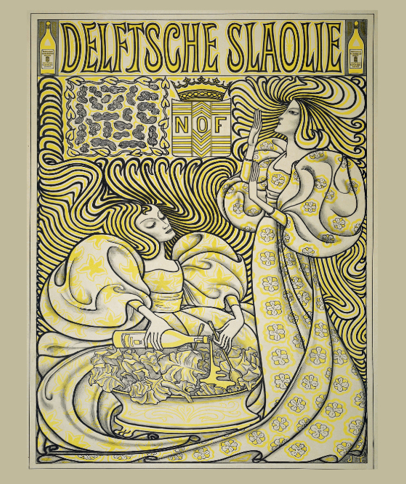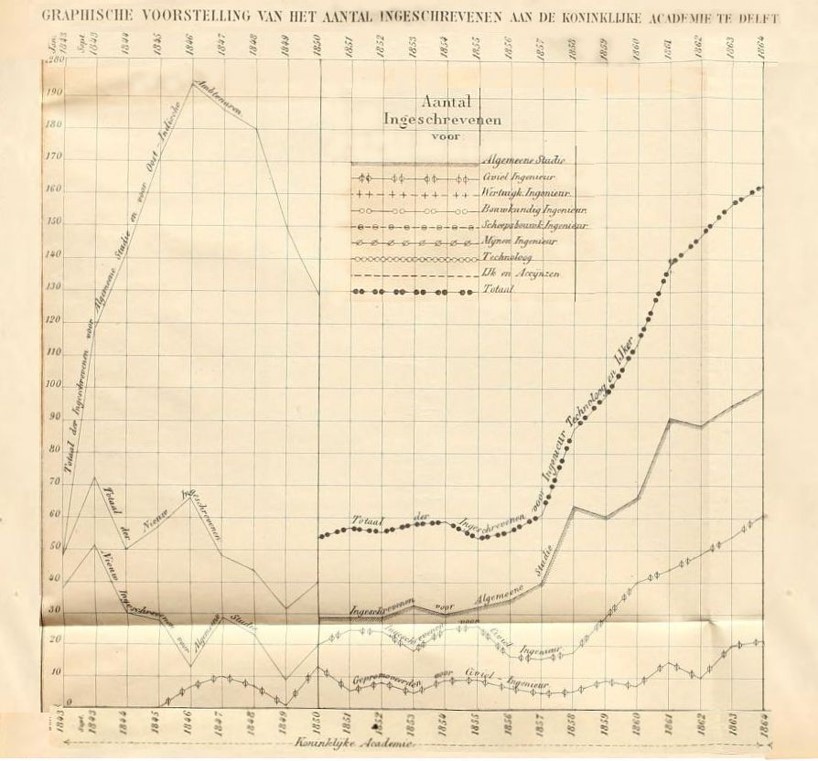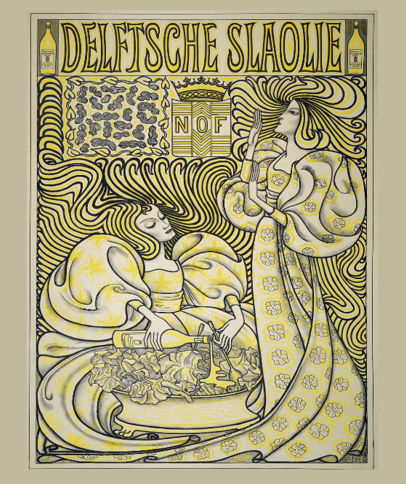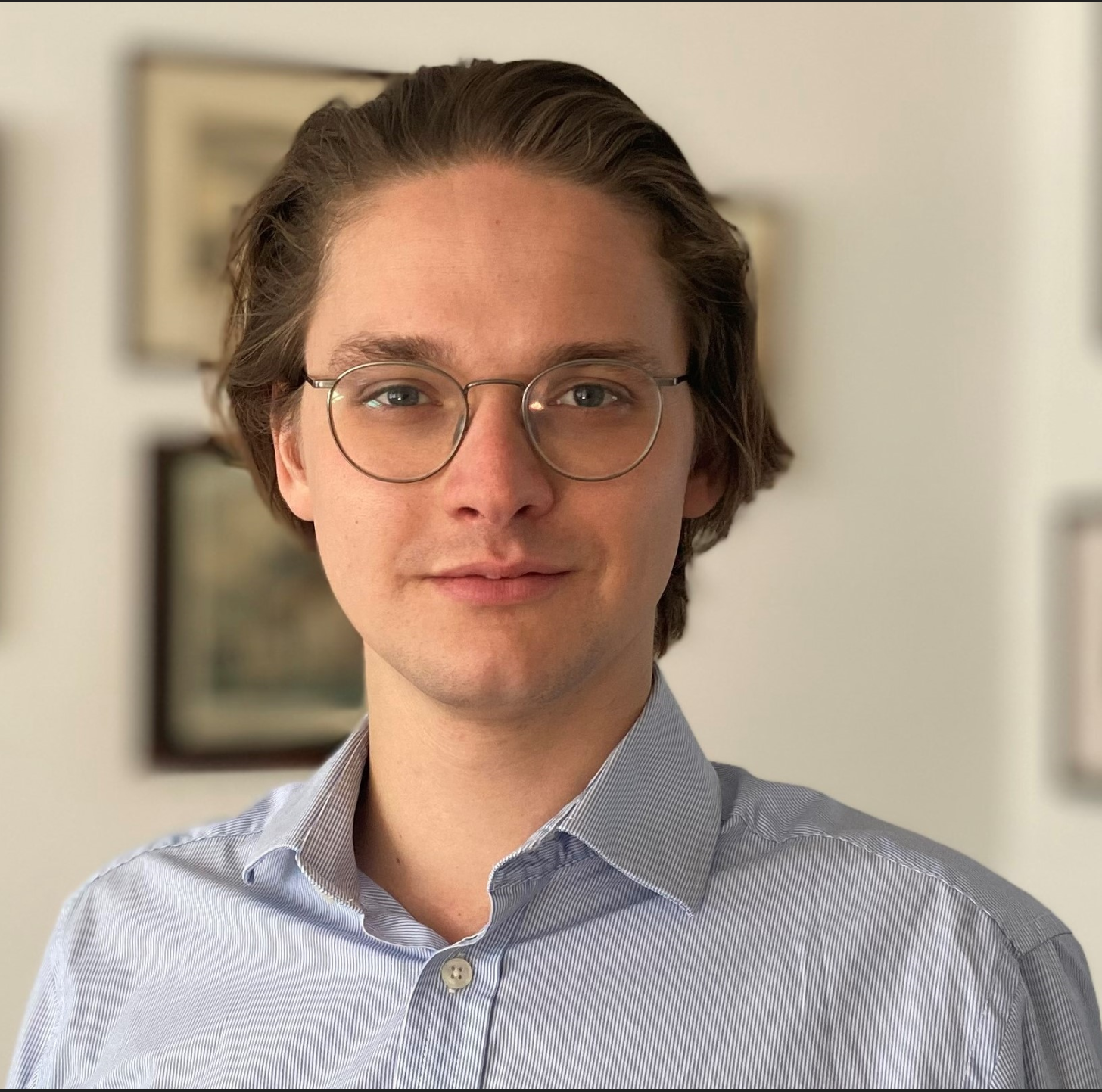11.11.2021by David van Driel
Van Keramiek tot Quantum/From Ceramics to Quantum Mechanics

How Delft became the city of quantum (part 1)
by David van Driel

Bounce a coin off the walls of the Applied Physics building at the Delft University of Technology and chances are you hit a qubit. Yet when most people think about Delft, they talk about Johannes Vermeer, DSM or Delfts Blauw porcelain. How did an industrial town in The Netherlands wrestle its way to the front row of the Quantum Revolution? In this first blog post, I will trace the threads of history from the times of Delfts Blauw to the old quantum theory.
Every scientific discovery has a head and a tail, but their separation can be quite long. A paradox of the geometric series[1] formulated by Zeno of Elea in 495-430 BC was solved only 1800 years later by Nicole Oresme[2] in 1360 AD[3]. There are many examples of this kind, but a great one is black body radiation. Tracing the history of black body radiation leads us through some of the most interesting periods of Delft. This might seem like quite a stretch, but Zeno’s example demonstrates that problems can be formulated long before their solution.
Our story of ceramics and quantum mechanics starts with art and science. More specifically, paintings and microscopy. An unlikely friendship? A friendship I find exemplary for the history of Delft starting in the 17th century. A friendship whose existence is sometimes cast in doubt by historians. A friendship between Anthonie van Leeuwenhoek and Johannes Vermeer. The inventor of the microscope and the painter of Girl with a Pearl Earring. They were born in the same church in Delft within two weeks of each other, anno 1632. Vermeer painted a portrait titled ‘the geographer’, which is suggested to depict Van Leeuwenhoek. The latter did his exam to become a land surveyor in the same year as that painting. The year and profession check out. People say that Vermeer’s paintings have a photograph-like quality. His treatment of light is nearly impossible without an apparatus. Experts suspect he used a ‘camera obscura’[4]. This is a device that uses a lens to project and enlarge a scene. It was popular for observing eclipses. Meanwhile, Van Leeuwenhoek was grinding lenses of his own. He kept his methods secret, but could achieve a magnification factor of 270. When Vermeer died, Van Leeuwenhoek was appointed executor of his testament[5].
Personally, I don’t think the truth to their friendship matters. The most amazing thing is that a brilliant inventor and a legendary painter were contemporaries in Delft. When Van Leeuwenhoek died, he left the field of microbiology to the world. His remains are buried beneath the Old Church. The inscription of his grave reads: “Hier legt de gryse weetenschap in Leeuwenhoek begraven”. Freely translated: “here, the gray science lies buried with Van Leeuwenhoek”. Science would never be without color anymore after his passing. And Delft would be seeing a whole lot of color in the ages to come. But what color does an object emit when heated and why?
Do not all fix’d Bodies, when heated beyond a certain degree, emit Light and shine; and is not this Emission perform’d by the vibrating motion of its parts?[6]
This question was not proposed in Max Planck’s 1900 AD theory on black-body radiation[7]. It was rather raised by Isaac Newton in his book Opticks, anno 1704, two centuries earlier. He published a series of rhetorical questions to be known as ‘the queries’. Using analogy, Newton hoped to prove that light and heat were connected by some mechanical activity in a black body. Again, the question turned out to be too difficult to solve in a few lifetimes.
While apples were dropping on Newton’s head, the city of Delft had found her own raison d’être; Delfts Blauw. Chinese porcelain proved to be extremely popular in The Netherlands in the 16th century. Unfortunately, this porcelain was only affordable by the ultra-rich of the low lands. Dutch ceramists found that they could mimic the quality of porcelain by adding bone marrow to their earthenware, allowing for thinner pottery. To complete the analogy with Chinese porcelain, they painted the ceramics with Orientalist themes. This general hype of copying Chinese culture includes arts, gardens and architecture. The style is called Chinoiserie and was common throughout Europe at the time (consider also Azulejo from Portugal). Delfts Blauw became extremely favoured between 1650 and 1750, leading to 100 ceramics factories in operation at its peak popularity[8]. One of these is called Royal Delft and is still in business today. The economic success did not last for long though. Between 1680 and 1730, the city of Delft lost nearly a third of its population, despite the success of Delfts Blauw [9]. The Dutch Golden Age had drawn to a close after the ‘Disaster Year’ of 1672 for reasons beyond the scope of this blog. An increasing cost of living drove the city of Delft to near poverty, in which it remained for some time. It wasn’t long then until Napoleon conquered The Netherlands and dissolved its republic.
What the hell was that?
– Louis Napoléon Bonaparte
BOOM! Emperor Napoléon’s younger brother ‘Louis’ is standing on the Dam Square in Amsterdam and hears a distant blow[10]. A ship carrying 1.7e4 kg of gunpowder has just exploded in the middle of Leiden. The young King of a French-controlled Holland visits the site of the Gunpowder disaster only to find many of Leiden’s finest houses destroyed.

Despite the traumatic consequences of the explosion in 1807, many artillery schools were opening in The Netherlands at the time. A year after French occupation had ended, Willem I opened the artillery and military engineering school in Delft in 1814. I will ask the reader: which Willem is this? William the Silent? King Willem I? William I of Baux? I’d like to stress here that Regnal numbers aren’t good quantum numbers. The right answer is: King Willem I, who ascended the throne after Napoleon’s defeat in Leipzig[11]. Willem I’s artillery school existed only until 1828, but you can still find the original building at Oude Delft 95. When her doors opened again on January 8th 1842, they wouldn’t host an artillery school though. That day marks the foundation of our Delft University of Technology. In those days, people called it the Royal Academy for the Education of Civil Engineers. There were four types of study[12]: maritime engineering and mining, civil services for the East Indies, governmental finance and civil engineering, which included all the natural sciences. The student numbers can be seen in the figure below[13]:

Already then was black-body radiation being studied by Gustav Kirchhoff, who’s usually known from his current conservation laws. In staying with conservation, he used the second law of thermodynamics to make claims about black-body radiation. He specifically proved that opaque bodies in thermal equilibrium have the same emissivity and absorptivity coefficients. This is no quantum mechanics yet, but he is clearly standing on the shoulders of Isaac Newton. The year of Kirchhoff’s theory is 1859. The world will have to wait 41 years before Max Planck’s view on the matter [14].
Kirchhoff had to wait a little less than 41 years for something exciting to happen though. From 1871 to 1873, he was teaching one the most promising bachelor students of his time: Heike Kamerlingh Onnes[15]. Due to the poor conditions of laboratories in Utrecht, a professor encouraged Onnes to study in Heidelberg instead. After returning to Groningen to finish his studies, our story turns to Delft again. Here, Kamerlingh Onnes would serve as a scientific assistant for Johhanes Bosscha, chair of the then called Polytechnic School of Delft. Bosscha also motivated Van der Waals to pursue a PhD[16]. Between 1878 and 1882, Onnes would research and eventually publish his ‘Algemeene theorie der vloeistoffen’ (general theory of fluids)[17]. This might seem far-fetched from his discovery of superconductivity in 1911, but it is not. He started working on the liquefaction of gasses right after his inauguration as a professor in Leiden and would need to know the phase diagrams. Liquid helium was used to cool mercury, tin and lead into the superconducting phase. But this is jumping ahead. The ‘70s and ‘80s of the 19th century were not the stage for quantum mechanics yet. They were rather witness of the great electromagnetism theories of Helmholtz and Maxwell[18]. In between the two, Hendrik Antoon Lorentz was writing his thesis that used Helmholtz’ theory to explain refraction[19]. As we can see, the seeds that would grow into the old quantum mechanics were already blowing through the world. The seeds were still dormant then, waiting to germinate.
The end of the 19th century was the time of industry and commerce. It was the time of Heineken and patents. It was the time when Philips opened operations in Eindhoven, originally to make light bulbs. Meanwhile, Delft was finally recovering economically after an age of deep poverty. Big industry was starting to establish itself. An especially famous company was the “Koninklijke Nederlandsche Gist- en Spiritusfabriek” (Royal[20] Dutch yeast and spiritus factory). This company is still in operation under the name “DSM” nowadays. The origins of peanut butter also lie at the turn of the century. The brand ‘Calvé’ started as the Dutch Oil Factory (“Nederlandse Oliefabriek”). They famously made Delftsche sla-olie (salad oil) at first.
I’d like to take the time here to emphasise this unique period of history where art, business and science united. Art Nouveau arose as an art form to mock the industrialisation. Where industry was sharp-edged and dark, Art Nouveau was curvy and colourful. The Czech artist Alfons Mucha was famously hired to make Art Nouveau commercials for JOB cigarettes and Möet & Chandon champagne. The enterprising Dutch recognised this art form as a nice way to market their products. The Dutch Oil factory hired Jan Toorop to design a label for their salad oil. The resulting affiche became so famous that the entire Dutch Art Nouveau style was called ‘slaoliesijl’ (salad oil style)[21].

Note here that a wave of companies and commerce started after chemistry established itself as an academic discipline at the university of Delft. Might the same thing be happening for quantum technologies? To answer that question, we first need to reach the Old Quantum Theory.
At the fin de siècle, Wilhelm Wien would weigh in on black body radiation. In 1893 he proposed a law that states the temperature-dependence of the wavelength for which most light is emitted[22]. Max Planck would turn his mind to black body radiation a year later.
h
– Max Planck
Has a single character ever had such an impact? Has it set in motion a chain of events that would lead to quantum supremacy? Max Planck was able to solve the puzzle of black body radiation by proposing that electromagnetic energy was quantised. Imagine the shock this must have caused among the physicists of his day and age[23]. Planck’s spectral equation stood its ground, no matter how much it was shaken. The year of 1900 marks the start of the Old Quantum Theory, the semi-classical theory which uses quanta to hotfix the bugs of classical physics. The actual field of quantum mechanics would still have to wait for the wave mechanics of Erwin Schrödinger and Louis de Broglie[24].
I choose to leave the reader in the annus mirabilis of physics. In his “miracle year” of 1905, Einstein published four remarkable papers in four remarkable fields. The subjects being: mass-energy equivalence, special relativity, Brownian motion and the photoelectric effect. Another miracle would occur in 1905; the Polytechnical School of Delft became the ‘Technische Hoogeschool’ and obtained the right to award doctorates. In 1905, Lorentz got his nobel prize 3 years before. In 1905, the mostly-chemical industry of Delft is in full swing and Willem Einthoven takes his first electrocardiogram in Leiden. Only 12 years later marks the birthday of the promotor of Hans Mooij, forefather of the currently blossoming Delft quantum scene. In 1905, the city of Delft is waiting for Kramers, Kronig and De Haas.
To be continued…

David van Driel’s passion for quantum computing took him all the way from Leiden to Delft. He works on semiconductor-superconductor physics in the group of Leo Kouwenhoven. While this may sound very scientific, the daily practice amounts to putting things on top of other things (on the nano scale). He likes writing history-themed posts to not compete with the intellectual bloggers that can explain their work in 800 words. In his free time, he likes playing guitar, reading 20th century books and trying to crack the stock market with machine learning.
[1] Explained in 60 seconds here, the series is: \(\sum_{n=1}^{\infty} (1/2)^n = 1\)
[2] Oresme, Nicole (c. 1360). Quaestiones super Geometriam Euclidis[Questions concerning Euclid’s Geometry].
[3] Strangely, some PhD-students complain that a mere 4 years of science only advances their field by an ångstrom
[4] https://www.youtube.com/watch?v=7kxWCQiPnD8
[5] https://blog.cmog.org/2016/11/17/the-uncertain-friendship-of-van-leeuwenhoek-and-vermeer/
[6] Newton, Isaac (1704). Opticks
[7] Planck, M. (1900a). “Über eine Verbesserung der Wien’schen Spectralgleichung”. Verhandlungen der Deutschen Physikalischen Gesellschaft. 2: 202–204
[8] Aken-Fehmers, M.S. van & L.A. Schledorn, A.G. Hesselink, T.M. Eliëns, (1999) Delfts aardewerk. Geschiedenis van een nationaal product, deel 1, Zwolle/Gemeentemuseum Den Haag.
[9] https://www.delftsaardewerk.nl/verdiepen/6691-delft-in-de-zeventiende-en-achttiende-eeuw
[10] The blow might only have been audible up to The Hague. Forgive my usage of all the random oral knowledge I’ve received over the years.
[11] https://www.koninklijkhuis.nl/onderwerpen/koningen-en-koninginnen/willem-i-koning-1772-1843
[12] J.A. Bruggemans. “TH Delft tot 1956” op Nationaal Archief, Den Haag 1983. (Tekst CC0).
[13] Vereeniging van Delftsche Ingenieurs; Koninklijk Instituut van Ingenieurs, Koninklijke Academie te Delft, studentenaantallen 1843-1864
[14] Kirchhoff, G. (1862). Appendix, Über das Verhältniß zwischen dem Emissionsvermögen und dem Absorptionsvermögen der Körper für Wärme und Licht, to Untersuchungen über das Sonnenspectrum und die Spectren der chemischen Elemente, Ferd. Dümmler’s Verlagsbuchhandlung, Berlin, pages 22–39. Reprinted with the same title in Kangro, H. (1972), Otto Zeller Verlag, Osnabrück, ISBN 3-535-00820-4, pages 45–64.
[15] https://www.dbnl.org/tekst/delf006heik01_01/delf006heik01_01_0007.php
[16] Stam, W. G. (2017). Johannes Bosscha Jr.(1831-1911) and the development of the field of physics in the Netherlands in the second half of the 19th century (Master’s thesis).
[17] Onnes, Heike Kamerlingh. Algemeene theorie der vloeistoffen. Vol. 21. Johannes Müller, 1881.
[18] Woodruff, A. E. (1968). The contributions of Hermann von Helmholtz to electrodynamics. Isis, 59(3), 300-311.
[19] Vanpaemel, G. (2021). Frits Berends en Dirk van Delft, Lorentz. Gevierd fysicus, geboren verzoener.
[20] Read this to find out why certain companies have a royal title.
[21] The Prinsenhof had a very nice exhibit about this once.
[22] Ball, D. W. (2013). Wien’s displacement law as a function of frequency. Journal of Chemical Education, 90(9), 1250-1252.
[23] http://materias.df.uba.ar/f4ba2015c1/files/2012/08/papers-planck.pdf
[24] Ter Haar, D. (2016). The Old Quantum Theory. Elsevier.

